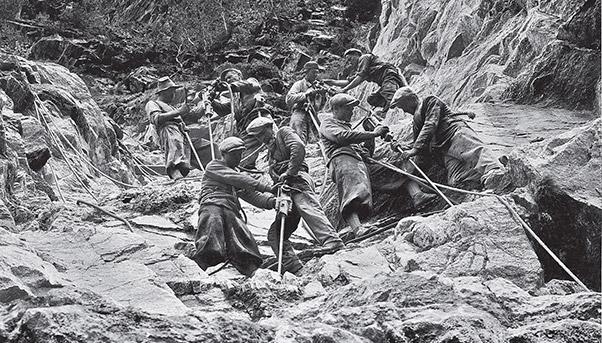
What
do workmen talk about on their lunch break, sitting on a steel beam at
the top of a skyscraper? It is both an intimate moment and a collective
history, captured together by a photographer’s click. On one hand we see
the men’s faces, full of fatigue and satisfaction; on the other, the
epic story where they play a leading role: the construction of the
Rockefeller Center, one of the symbols of New York City and of America’s
rebirth after the Great Depression. In 1932, on September 19 to be
exact, Charles Clyde Ebbets (the most likely author of a photograph that
still hides a few mysteries) snapped the “Lunch atop a Skyscraper” that
immortalizes the workmen during their break and created an image that
is hard for anyone to forget.
It is this same magic that envelops the oil well fire fighter Paul “Red”
Adair, soaked in crude oil as he struggles to put out a blaze in
Kuwait’s wells with dynamite, photographed by maestro Sebastião Salgado.
It is 1991, and this photograph becomes a poster for the first Gulf War
just as it was coming to a close. There are other photographs by
Salgado that depict work in a completely different way, not as a vehicle
for development – as a form of desperation, where the poorest people on
the planet struggle in a form of modern slavery, like the half-naked
men he photographed covered in mud in the gold mines of Sierra Pelada in
Brazil, where they toil in inhuman conditions seeking their fortune.
Thanks to the contribution of masters like these, photography has become a tool to narrate the evolution of professional know-how and the achievements of the human race.
Be they snapshots in black and white, posed portraits, or stolen images
of men as they climb sheer cliff walls, their strength lies precisely
in their ability to represent the immediacy of a moment, but also of the
absolute importance of the labors of mankind.
This representation of man also shows the importance of his
work, as well as the passage of time, the social and historical context,
and economic development. There are many photographers who
through their work became eyewitnesses to the Industrial Revolution. And
there are many that captured the golden age of infrastructure, when
pioneers set out to build works that would become universal symbols.

Goglio Hydroelectric Plant – Italy 1936
The first images of railways and railways stations spring to mind,
photographed in the 1800s by Edouard-Denis Baldus, or the images of
London’s Crystal Palace by Philip Henry Delamotte, or Delmaet and
Durandelle’s snaps capturing the most important moments of the
construction of the Eiffel Tower. Or the work of Gabriele Basilico, one
of the most well-known photographers of urban landscapes in the world.
His reportages from Milan, Shanghai, Istanbul, Silicon Valley, Rio de
Janeiro and Beirut are slices of life that bear witness to the story of
today’s urban agglomerations.
All of these experiences offer yet more proof of how man’s challenge to
realize epic infrastructure works has always captured the imagination of
the world’s great photographers, because stealing those images means
immortalizing an historic moment and telling the story of a world that
is destined to change.
Cyclopica, a photographic voyage
From the shots by British photographer John Myers of crumbling abandoned factories in the U.K. to Sweden’s Mårten Lange and his portraits that tell the tale of the solitude of today’s white collar employees, photography is capable of capturing the soul of a moment forever and then letting us relive it each time we stop to look.
This is the idea behind “Cyclopica,” the photography
exhibition organized by Salini Impregilo from May 1 to June 3 at Milan’s
Triennale. The show will recount moments lived by people in distant
lands and their epic adventures, and the unique experience of working
with hundreds of other people to build a large infrastructure project. The
men who opened a gap in the American continent to build the Panama
Canal, or the ones who brought electricity to Italy, contributing to the
country’s industrialization, thanks to the dams built by Edison in the
remotest towns in the Alps (immortalized by director Ermanno Olmi), or
dug tunnels burrowing hundreds of metres into the Earth show us how
they work. And with their work they create a Cyclops, or those
infrastructure giants that have helped entire populations grow.
It is through the relationship of man and the Cyclops – or between dwarf
and giant, but also between wits and strength – that over 2,000
infrastructure projects come to life through Salini Impreglio’s history
of over a century.
This relationship has been captured in over 1.2 million
images and 600 videos, conserved in the Salini Impregilo archives, from
photographers that the group relied on to convey its desire to talk
about its evolution from its origins 110 years ago to the present.
It was Antonio Paoletti and Guglielmo Chiolini who at the start of the
1900s were the first to preserve a record of life on a building site,
highlighting ambivalence about the difference between the enormity of
the structures and the human dimension – while still keeping man in the
foreground. Armin Linke, Moreno Maggi, Edoardo Montaina and Filippo
Vinardi took the same approach through the years right up to the most
recent works.
Today these images are being shared with the public in a selection that
takes the visitor on a voyage in time and space, through different
historic epochs and to faraway countries.

